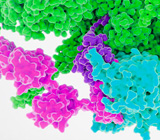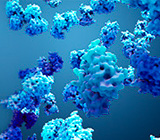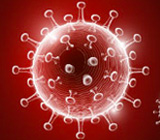-
REAGENT SERVICES
Hot!
-
Most Popular Services
-
Molecular Biology
-
Recombinant Antibody/Protein
-
Reagent Antibody
-
CRISPR Gene Editing
-
DNA Mutant Library
-
IVT RNA and LNP Formulations
-
Oligo Synthesis
-
Peptides
-
Cell Engineering
-
- CRISPR/Cas9 sgRNA
- CRISPR/Cas12a crRNA
- Prime Editing Guide RNA
- Base Editing Guide RNA
- HDR Templates
- gRNA + HDR Template Design Tools
- cGMP Guide RNA
- cGMP HDR Templates
- CRISPR/Cas Proteins
- CAR-T Knock-in Optimization Kit
- CRISPR Plasmids
- CRISPR gRNA Plasmid Libraries
- CRISPR Cell Lines
- Microbial Genome Editing
-
-
PRODUCTS
-
Most Popular Reagents
-
 Instruments
Instruments
-
Antibodies
-
ELISA Kits
-
Protein Electrophoresis and Blotting
-
Protein and Antibody Purification
-
Recombinant Proteins
-
Molecular Biology
-
Stable Cell Lines
-
Cell Isolation and Activation
-
 IVD Raw Materials
IVD Raw Materials
-
 Therapy Applications
Therapy Applications
-
Resources
-
- Pharmacokinetics and Immunogenecity ELISA Kits
- Viral Titration QC ELISA Kits
- -- Lentivirus Titer p24 ELISA KitHot!
- -- MuLV Titer p30 ELISA KitNew!
- -- AAV2 and AAVX Titer Capsid ELISA Kits
- Impurity Test ELISA Kits
- -- BSA ELISA Kit, 2G
- -- Cas9 ELISA KitNew!
- -- Protein A ELISA KitNew!
- -- His tagged protein detection & purification
- -- dsRNA ELISA Kit
- -- Endonuclease ELISA Kit
- COVID-19 Detection cPass™ Technology Kits
-
- Automated Maxi-Plasmid PurificationHot!
- Automated Mini-Plasmid PurificationNew!
- PCR Reagents
- S.marcescens Nuclease Benz-Neburase™
- DNA Assembly GenBuilder™
- Cas9 / Cas12a / Cas13a Nucleases
- Base and Prime Editing Nucleases
- GMP Cas9 Nucleases
- CRISPR sgRNA Synthesis
- HDR Knock-in Template
- CRISPR Gene Editing Kits and Antibodies
-
![AmMag™ Quatro Automated Plasmid Purification]() AmMag™ Quatro automated plasmid purification
AmMag™ Quatro automated plasmid purification
-
![Anti-Camelid VHH]() MonoRab™ Anti-VHH Antibodies
MonoRab™ Anti-VHH Antibodies
-
![ELISA Kits]() ELISA Kits
ELISA Kits
-
![Precast Gels]() SurePAGE™ Precast Gels
SurePAGE™ Precast Gels
-
![Quatro ProAb Automated Protein and Antibody Purification System]() AmMag™ Quatro ProAb Automated Protein and Antibody Purification System
AmMag™ Quatro ProAb Automated Protein and Antibody Purification System
-
![Target Proteins]() Target Proteins
Target Proteins
-
![AmMag™ Quatro Automated Plasmid Purification]() AmMag™ Quatro automated plasmid purification
AmMag™ Quatro automated plasmid purification
-
![Stable Cell Lines]() Stable Cell Lines
Stable Cell Lines
-
![Cell Isolation and Activation]() Cell Isolation and Activation
Cell Isolation and Activation
-
 IVD Raw Materials
IVD Raw Materials
-
![Quick
Order]() Quick Order
Quick Order
-
![Quick
Order]() Quick Order
Quick Order
- APPLICATIONS
- RESOURCES
- ABOUT US
- SIGN IN My Account SIGN OUT
- REGISTER

![Amino Acid Code Amino Acid Code]()
Biology Terms Dictionary
This Biology terms dictionary provides query services for biology and biochemistry terms. Please enter the biology or biochemistry terms you want to search.
List by Alphabet: A B C D E F G H I J K L M N O P Q R S T U V W X Y Z
Protein Expression
Introduction
Protein expression refers to the process by which cells synthesize, modify, and produce proteins based on genetic instructions encoded in DNA. In biological research, biotechnology, and pharmaceutical industries, recombinant protein expression is crucial for producing enzymes, therapeutic proteins, vaccines, and diagnostics. The expression of proteins can occur in different systems—bacteria, yeast, insect, and mammalian cells—depending on the complexity of the protein and its required modifications.
The process involves cloning the gene of interest, introducing it into a suitable host system, optimizing expression conditions, and purifying the expressed protein. Each expression system offers distinct advantages but also presents challenges in terms of scalability, post-translational modifications, and production efficiency.
Mechanisms of Protein Expression
1. Gene Cloning and Vector Construction
The process begins with the identification and isolation of the gene encoding the protein of interest. This gene is cloned into an expression vector, which carries essential elements such as:
• Promoters: Drive gene transcription (e.g., T7 promoter for bacterial systems, CMV promoter for mammalian systems).
• Selection Markers: Ensure that only successfully transfected cells survive (e.g., antibiotic resistance genes).
• Tags: Such as His-tag or FLAG-tag, to facilitate purification. Codon optimization is often performed to ensure that the gene matches the host system’s tRNA availability, enhancing translation efficiency.
2. Expression Systems
1. Bacterial Systems (E. coli)
• Advantages: Fast growth, cost-effective, easy scalability.
• Disadvantages: Limited post-translational modifications; insoluble protein aggregates may form.
• Applications: Enzyme production, small research proteins.
2. Yeast Systems (Pichia pastoris, Saccharomyces cerevisiae)
• Advantages: Capable of some post-translational modifications (e.g., glycosylation).
Disadvantages: Glycosylation patterns differ from those in humans.
Applications: Industrial enzymes, vaccines, and diagnostics.
3. Insect Systems (Baculovirus)
Advantages: Can produce complex proteins with PTMs.
Disadvantages: Production times are longer; scalability can be challenging.
Applications: Production of viral proteins, vaccines, and research reagents.
4. Mammalian Systems (CHO, HEK293)
• Advantages: Perform human-like PTMs, ideal for therapeutic proteins.
• Disadvantages: High production costs, time-consuming development.
• Applications: Monoclonal antibodies, hormones, vaccines, and viral vectors.
Upstream and Downstream Processing
1. Upstream Processing
Upstream processing focuses on cultivating cells under optimal conditions to maximize protein yield:
• Media Optimization: Ensuring that the growth media contains appropriate nutrients and supplements.
• Transfection or Transformation: Introducing the expression vector into the host system via transfection (mammalian cells) or transformation (bacteria, yeast).
• Induction of Protein Expression: Using inducers like IPTG (in bacterial systems) to initiate protein production.
2. Downstream Processing
Downstream processing involves the isolation and purification of the expressed protein, followed by quality control:
• Protein Purification: Affinity chromatography (e.g., Ni-NTA for His-tagged proteins) and ion-exchange chromatography are used to isolate proteins.
• Structural and Functional Validation: Techniques like SDS-PAGE, HPLC, and mass spectrometry confirm protein integrity and purity.
Glycosylation Analysis: For proteins expressed in eukaryotic systems, glycosylation patterns are analyzed to ensure consistency.
Advantages of Protein Expression
• Customizable Systems: Researchers can select expression systems based on the complexity of the protein and the required PTMs.
Scalability: Both small-scale (laboratory) and large-scale (industrial) production are possible.
• Versatility: Proteins produced can be used in pharmaceuticals, diagnostics, vaccines, and enzymes for industrial applications.
Rapid Prototyping: Systems like bacterial and yeast expression allow rapid screening of multiple proteins in research settings.
Industrial Applications
1. Therapeutic Protein Production
• Monoclonal antibodies: Produced primarily in CHO cells for treating cancers, autoimmune disorders, and infectious diseases.
Hormones and Cytokines: Examples include insulin, erythropoietin, and interferons, which require human-like PTMs for bioactivity.
2. Vaccine Production
Protein expression systems are used to produce viral proteins, subunit vaccines, and virus-like particles (VLPs) for vaccines, such as those against COVID-19 and influenza.
3. Enzyme Production
Industrial enzymes, such as amylases and proteases, are produced using bacterial or yeast systems for applications in detergents, food processing, and paper industries.
4. Diagnostic Tools
Proteins expressed in bacterial or yeast systems are used in diagnostic kits, such as enzyme-linked immunosorbent assays (ELISAs) and biosensors.
GenScript Services and Solutions
GenScript offers a comprehensive range of protein expression services, covering various expression systems to suit different research and industrial needs:
• Custom Protein Expression: GenScript supports bacterial, yeast, insect, and mammalian expression systems for recombinant protein production.
• Transient and Stable Expression Systems: Rapid protein production using transient transfection for early-stage research and stable cell line development for long-term production.
These services enable researchers and biopharmaceutical companies to efficiently produce high-quality proteins tailored to their specific applications.
Conclusion
Protein expression is a fundamental tool in biotechnology, enabling the production of proteins for pharmaceuticals, diagnostics, vaccines, and industrial enzymes. The choice of expression system depends on the complexity of the protein and the required post-translational modifications. With advancements in biotechnology, including synthetic biology and continuous bioprocessing, the efficiency and scalability of protein expression systems are improving. As these technologies evolve, protein expression will remain at the forefront of biological research and biomanufacturing. Visit Protein & Antibody Academy to explore cutting-edge protein and antibody knowledge.
- Tags:
- Protein
Related Biology Tools
-
GenSmart™ Codon Optimization
GenSmart Optimization is a free online tool for performing codon optimization to improve gene expression. GenScript's patented algorithms are integrated into the tool to optimize the computing capability of high-performance sequence generation.
-
DNA Construct Design Tool
GenSmart™ Design is a free online DNA construct design tool developed by GenScript. GenSmart™ Design has two design modules, the Create Construct module for individual plasmid design and the Create Library module for DNA library design.
-
Codon Frequency Tables
This online tool shows commonly used genetic codon frequency table in expression host organisms including Escherichia coli and other common host organisms.
Service and Products

Protein Expression
GenScript recombinant protein and rAb services provide high quality recombinant proteins and rAbs for a variety of downstream research applications.

Bacterial Expression
One-stop service from Sequence to Protein starting from $1600, 4 weeks.

Insect Expression
GenScript's BacuVance baculovirus expression system was developed by our in-house team of scientists for virus production and expression of recombinant proteins from baculovirus-infected insect cells.

Mammalian Transient Expression
Proprietary High Density (HD) expression system, enhance the protein yield up to 100 fold, achieve antibody titers up to 3 g/L.

Reagents for COVID-19 Research
Gram level, ready to ship RBD proteins, ACE2 assay cell lines and pseudovirus.
-
Top Search
-
Hot Glossary
-
Antibody
If you know of any terms that have been omitted from this glossary that you feel would be useful to include, please send detail to the Editorial Office at GenScript: website@genscript.com
If your term is adopted, we will send 1,000 EzCoupon points to your GenScript account.
-





































